Market

December 9, 2021
Ferrous Scrap Prices Flat in December on Weak Export Demand
Written by Tim Triplett
Ferrous scrap prices for December settled mostly sideways across the U.S. following a big jump in November as export demand slowed and as mills sought to reduce year-end inventories.
Steel Market Update sources generally put December scrap in the following ranges: Shred $520-540/GT; Bush $600-640/GT; and HMS $470-490/GT.
“It was an unusual, and frankly unexpected, December ferrous trade,” said one dealer in the Northeast. “December is normally not a month in which dealers need to worry about where they will place their scrap or whether they will get more money for it than they did the prior month. This year – due to weakening exports resulting from the plummeting Turkish currency and soft Asian steel demand – there was excess shredded scrap looking for a home in the U.S.”
Fears that Turkish markets will continue to weaken into January convinced exporters to unload scrap now, stealing any upward momentum from domestic markets. This even pushed obsoletes, including prices in the Midwest and the South, lower than last month by $10-20/GT. “But dealers who concluded transactions last week did end up with sideways prices in December, and prime generally traded sideways across the board,” he said.
Weak scrap exports are likely to keep downward pressure on scrap prices at least for the near term, sources agreed. “Looking forward, we do not see any strength in the export markets for the foreseeable future, and lower prices than we have today ($470-$475/MT cif for 80/20) are quite possible,” said one dealer.
Many U.S. domestic buying programs were much smaller than usual in December, but most mills are expected to return to more normal programs in January, he added. “We are living in a bizzarro world with a sideways to negative bias in December and January. But it’s not so bizzarro that we’ll have spring or summertime flows this time of year. So between weather factors and improved demand in January, look for some stabilization and even a rebound at some point during or right after the January trade.”
December scrap traded sideways – below expectations – in all regions except the Southeast, reported another dealer. The mains reason: a falling export market and U.S. exporters selling more scrap domestically, year-end inventory reductions, and unplanned outages.
“In my opinion, scrap prices have peaked for a bit, primarily because of the weak export market. But they will still stay far higher than historical levels. The added steel mill capacity will create significant demand for ferrous scrap. That should keep a floor on price levels. And (scrap prices have) the potential to rise further as these new mills come online in H2,” he said.
“December is a strange month for the scrap industry. The tenor of the market is upward. But mills are hesitant to buy major tons as they try to adjust their year-end inventories for tax purposes. So, sideways pricing for December is not surprising, especially at these price levels,” commented another source.
The rise in scrap prices normally expected in January may still be affected by the declining export market in Turkey and the lack of scrap demand in Southeast Asia. “The U.S. mills will try to keep a lid on prices, but it remains to be seen if the factors line up to make this possible,” he added.
Steelmaker Cleveland-Cliffs made a big splash in the scrap market with its purchase in October of Ferrous Processing and Trading, a major scrap processor in the Midwest. The deal has raised speculation about how this merger might impact the scrap trade going forward. Here’s one scrap veteran’s view: “I am sure there will be some impact, but it’s hard to say what it will be from month to month. Cliffs will consume that scrap themselves for the most part. Where other mills will source replacements for it depends on the month and the season. Beyond noting that other mills in the Ohio and Michigan markets may have to reach a little farther and pay a little more for prime scrap, we will have to wait and see.”
Market observers keep a close eye on mills’ ferrous scrap costs as a leading indicator of finished steel prices.
Pig Iron Market
Reports an SMU contact in the pig iron market: “The market for pig iron is stalled right now as questions about the scrap markets are causing concern. The scrap markets, foreign and domestic, are looking weaker. U.S. mills are not anxious to buy PI and are looking for much cheaper prices when they do decide to book. A Chinese cargo attempted to divert to the U.S. from S. Brazil, but it could not find a buyer, even at potentially discounted prices from the last sale at $570/MT cfr.”
By Tim Triplett, Tim@SteelMarketUpdate.com
The post Ferrous Scrap Prices Flat in December on Weak Export Demand appeared first on Steel Market Update.






